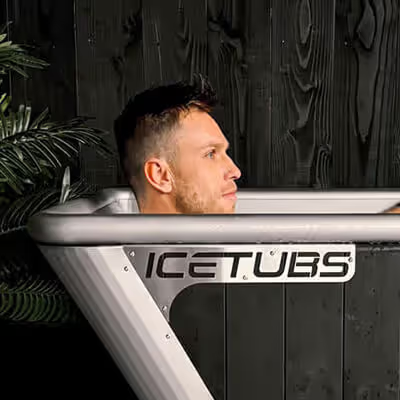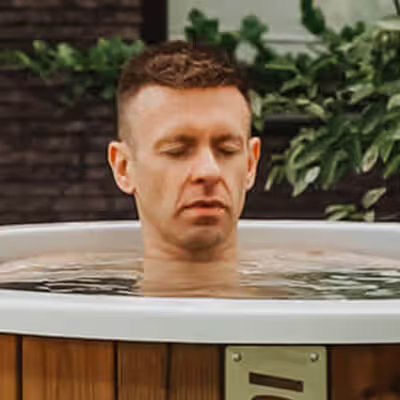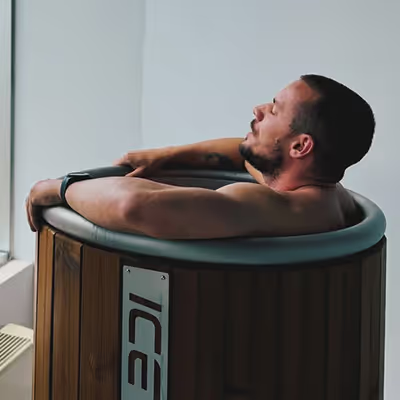Trusted by 1000+ athletes & professionals

Rico Verhoeven

Joy Beune

Nicky Romero

Chema Martinez

Manon Angonese

Jan Tournier

Why heat therapy is more than just “getting warm”
From ancient rituals to modern wellness routines, saunas have always been about more than just sweating. High heat stimulates circulation, relieves tension, and signals your body to relax. And when used consistently, it helps you sleep deeper, manage stress, and recover faster. Add the contrast of cold therapy, and you’ve got a recovery tool like no other.
Download the Free Heat Therapy Guide
Curious if sauna therapy is right for you?
Get our free guide packed with science-backed benefits, beginner routines, and expert tips for getting the most out of your heat (and contrast) sessions.

What is hot therapy?
Heat therapy, also known as thermotherapy, involves the application of heat to specific areas of the body to relieve pain, promote healing, and improve overall health. It is a widely used method for treating musculoskeletal conditions, joint stiffness, and chronic pain.
Types of heat therapy
Heat therapy can be applied in various forms:
- Dry heat therapy: Includes heating pads, hot water bottles, and saunas. It is effective for prolonged use (up to 8 hours).
- Deep heat therapy: Involves hot baths, steamed towels, or moist heating packs. It penetrates deeper into tissues and provides faster relief (typically 15–30 minutes).
- Professional methods: Techniques like ultrasound heating or infrared wraps target deeper tissues for conditions such as tendonitis.
Proven benefits of heat & contrast therapy
Sauna therapy is backed by decades of scientific research:
Enhances cardiovascular health
People using saunas 4–7 times per week were 63% less likely to suffer sudden cardiac death.
Reduces the risk of stroke and dementia
Frequent sauna use is linked to a 62% lower risk of stroke and up to 66% lower risk of Alzheimer’s disease.
Improves mental health & sleep
Regular users report lower anxiety, less pain, better mood, and deeper sleep.
Supports muscle recovery & pain relief
Sauna sessions help flush lactic acid, reduce joint pain, and speed up physical recovery. Great after workouts, long days, or intense stress.
Builds resilience with contrast therapy
Alternating between heat and cold improves circulation, strengthens the immune system, and builds mental toughness.

What happens to your body in a sauna?
Spending time in high heat (typically 70–90°C) triggers physical and neurological responses that support better recovery, sleep, and energy.
- Blood vessels widen, increasing circulation
- Muscles relax and tension melts
- Sweating eliminates toxins
- Brain chemicals like serotonin and endorphins rise
- Stress hormones like cortisol drop
Check out our heat & contrast therapy products
We keep it simple but premium. Whether you want to upgrade your recovery with a sauna or go all-in with contrast therapy, our solutions are built to fit your space and elevate your daily routine.
Trusted by everyday achievers

Practice heat therapy at home with the IceSauna
Forget crowded and dirty gym or spa saunas. The IceSauna is built for private and wellness lifestyles.
- Electric heater
- Up to 90°C
- Indoor & outdoor use
- Four interchangeable looks
- Seats up to five people
- Removable benches for flexibility

Why contrast therapy completes the recovery cycle
Pairing hot and cold is more than a trend. It’s a time-tested system that supercharges recovery and builds real resilience.
This ancient hot/cold ritual:
- Improves circulation and blood flow
- Reduces muscle inflammation and stiffness
- Sharpens your focus and mental clarity
- Supports your immune system
- Helps regulate your mood and sleep
Ready to learn more about heat and contrast therapy?
The more you know, the better your routine becomes.
FAQs about heat therapy
Is using a sauna safe for beginners?
Yes! Start with short sessions (10–15 minutes) at lower temperatures (around 70°C) and gradually work your way up. Always stay hydrated and leave the sauna if you feel dizzy or overheated. If you have heart or respiratory issues, it’s best to consult your doctor before using a sauna.
How often should I use a sauna?
2 to 4 times per week is ideal for most people. Some users enjoy short daily sessions for mental clarity, stress relief, and better sleep. Like cold therapy, consistency matters more than intensity.
What is contrast therapy, and how does it work?
Contrast therapy means alternating between heat and cold — typically a sauna session followed by an ice bath. This temperature shift improves blood circulation, reduces inflammation, and helps your body recover faster. A basic routine could look like:
10–15 min sauna → 2–3 min ice bath → rest → repeat for 2–3 rounds.
Can sauna sessions help with stress or anxiety?
Absolutely. Sauna use reduces cortisol (the stress hormone) and increases endorphins and serotonin — helping you feel calmer, more balanced, and mentally clear. Many people report improved sleep and overall mood after just a few sessions.
What makes the IceSauna different from other saunas?
The IceSauna is built for daily use, with no firewood, no complicated setup, and no compromises. It’s electric-powered, heats fast (up to 90°C), and fits up to 5 people. With four interchangeable looks, removable benches, and screw-free assembly, it’s a design-forward solution that fits any home or garden.
Do I need a special installation or ventilation?
Not at all. The IceSauna is designed to be plug & play. It requires:
- One 400V 1/3N~ connection for the heater
- One 220V grounded outlet for the lighting
No chimney, no complex ducting. If you don’t already have the required outlet, a certified electrician can easily install it.
How much maintenance does the sauna require?
The IceSauna is nearly maintenance-free. There’s no ash, smoke, or filters to worry about. Just wipe down the inside after use and keep the space ventilated. It’s built with Thermowood and stainless steel, both extremely durable and easy to clean.
What’s included when I order?
When you order the IceSauna, you get everything needed for a complete, stress-free setup:
- Two-year warranty
- Harvia Cilindro PC90 electric heater + Finnish sauna stones
- Amber LED lighting
- Four configurable panel looks
- Power cords (heater + lights)
- Help desk
























